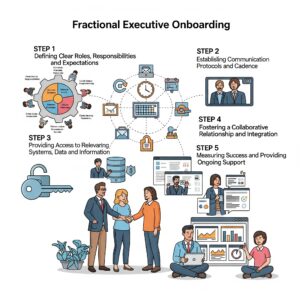The Rise of Fractional Executives and Why Onboarding Matters
 The fractional executive model has gained significant traction, particularly within finance and other back-office operations. Instead of a full-time CFO, Controller, or HR Director, businesses can access highly skilled professionals on a part-time, project-based, or retainer basis. This offers numerous advantages, including cost savings, access to specialized expertise, and scalability. According to a report by Grand View Research, the global fractional executive market is expected to grow substantially, driven by the increasing need for flexible and specialized talent.
The fractional executive model has gained significant traction, particularly within finance and other back-office operations. Instead of a full-time CFO, Controller, or HR Director, businesses can access highly skilled professionals on a part-time, project-based, or retainer basis. This offers numerous advantages, including cost savings, access to specialized expertise, and scalability. According to a report by Grand View Research, the global fractional executive market is expected to grow substantially, driven by the increasing need for flexible and specialized talent.
However, the success of a fractional executive hinges heavily on effective onboarding. Unlike a full-time employee who has time to gradually integrate into the company culture and learn the ropes, fractional executives need to hit the ground running. A poorly executed onboarding process can lead to frustration, delays, missed opportunities, and ultimately, a failure to achieve the desired results. Therefore, a well-defined onboarding playbook is crucial to ensure a smooth transition and maximize the value these executives bring to your organization.
Step 1: Defining Clear Roles, Responsibilities, and Expectations
Before the fractional executive even starts, clearly define their role, responsibilities, and the expected outcomes. This prevents misunderstandings and ensures everyone is aligned on what success looks like. This goes beyond a simple job description; it requires a detailed scope of work (SOW) outlining specific tasks, deliverables, timelines, and key performance indicators (KPIs).
Creating a Comprehensive Scope of Work (SOW)
The SOW should include:
- Project Objectives: What are the specific goals you want the fractional executive to achieve? For example, if hiring a fractional CFO, the objective might be to improve cash flow management or secure funding.
- Specific Tasks and Deliverables: List all the tasks the executive will be responsible for, along with the expected deliverables. Examples include developing a financial model, creating a budget, or implementing a new accounting system.
- Timelines and Deadlines: Set realistic timelines for each task and deliverable. Consider the executive’s availability and other commitments.
- Key Performance Indicators (KPIs): Define how you will measure the executive’s success. KPIs might include revenue growth, cost reduction, or improved efficiency.
- Reporting Requirements: Specify how often the executive will report on progress and the format of the reports.
- Decision-Making Authority: Clearly define the executive’s level of authority and who they will report to.
Example: Consider a fractional controller brought in to clean up a company’s chart of accounts and improve month-end close processes. The SOW should clearly outline the specific accounts to be reviewed, the steps involved in the cleanup process, the target timeline for completing the project, and the KPIs for measuring the success of the cleanup (e.g., reduced time to close, fewer errors in financial reporting).
Step 2: Establishing Communication Protocols and Cadence
Effective communication is paramount for the success of any fractional arrangement. Establish clear communication protocols and a regular cadence of meetings to ensure everyone stays informed and aligned. This is particularly important when the executive is not physically present in the office full-time.
Defining Communication Channels
Determine the preferred communication channels for different types of information. Consider using:
- Email: For routine updates, documents, and non-urgent communication.
- Instant Messaging (Slack, Microsoft Teams): For quick questions, real-time collaboration, and informal communication.
- Video Conferencing (Zoom, Google Meet): For scheduled meetings, presentations, and face-to-face discussions.
- Project Management Software (Asana, Trello): For tracking tasks, managing deadlines, and collaborating on projects.
Setting a Meeting Cadence
Establish a regular meeting cadence to discuss progress, address challenges, and provide feedback. The frequency and format of these meetings will depend on the executive’s role and the nature of the project. Consider the following:
- Weekly Check-ins: Short, informal meetings to review progress, identify roadblocks, and adjust priorities.
- Monthly Progress Reviews: More formal meetings to discuss overall performance, review KPIs, and plan for the next month.
- Ad-Hoc Meetings: Schedule meetings as needed to address specific issues or opportunities.
Example: A fractional CFO might have a weekly check-in with the CEO to discuss cash flow, a monthly meeting with the leadership team to review financial performance, and ad-hoc meetings with department heads to discuss budget variances. Make sure everyone understands how, when, and through what channel they will communicate.
Step 3: Providing Access to Relevant Systems, Data, and Information
Fractional executives need access to the same systems, data, and information as their full-time counterparts to effectively perform their duties. This includes access to accounting software, financial data, customer relationship management (CRM) systems, and other relevant tools.
Ensuring Secure and Timely Access
Work with your IT department to ensure the executive has secure and timely access to all necessary systems and data. This may involve setting up user accounts, granting permissions, and providing training on how to use the systems. Prioritize security by implementing multi-factor authentication and strong password policies.
Creating a Centralized Knowledge Base
Develop a centralized knowledge base that contains important company information, such as policies, procedures, organizational charts, and key contacts. This will help the executive quickly get up to speed and find the information they need.
Data Security and Compliance
Address data security and compliance concerns proactively. Ensure the fractional executive understands and adheres to your company’s data security policies and any relevant industry regulations (e.g., GDPR, HIPAA). Consider using a virtual private network (VPN) to secure remote access to your systems.
Example: A fractional HR director needs access to the company’s HR information system (HRIS) to manage employee data, benefits, and payroll. The IT department should create a secure user account for the executive and provide training on how to use the HRIS. Additionally, the HR director should be provided with access to relevant company policies and procedures.
Step 4: Fostering a Collaborative Relationship and Integration
While fractional executives are not full-time employees, they should be treated as valued members of the team. Fostering a collaborative relationship and integrating them into the company culture can significantly enhance their effectiveness and contribution.
Introducing the Executive to Key Stakeholders
Introduce the executive to key stakeholders, including team members, department heads, and other relevant personnel. This will help them build relationships and understand the dynamics of the organization.
Encouraging Open Communication and Feedback
Create an environment of open communication and feedback. Encourage the executive to share their ideas and insights, and provide them with regular feedback on their performance. Actively solicit their perspective as an outside expert.
Integrating the Executive into Team Activities
Invite the executive to participate in team meetings, social events, and other company activities. This will help them feel more connected to the organization and build rapport with their colleagues. Even virtual participation is better than none.
Example: A fractional marketing director might be invited to attend weekly marketing team meetings, participate in brainstorming sessions, and attend company-wide events. This will help them understand the company’s marketing strategy, build relationships with the marketing team, and feel more connected to the organization. If they can not attend in person, setting up a dedicated meeting camera to allow them to remotely “join” the meetings will boost inclusion.
Step 5: Measuring Success and Providing Ongoing Support
Regularly measure the executive’s progress against the established KPIs and provide ongoing support to ensure their success. This includes providing access to resources, addressing challenges, and offering constructive feedback.
Tracking Progress Against KPIs
Track the executive’s progress against the established KPIs on a regular basis. This will help you identify areas where they are succeeding and areas where they need more support. Utilize project management software or dashboards to visualize progress.
Providing Ongoing Feedback and Coaching
Provide the executive with ongoing feedback and coaching to help them improve their performance. This may involve providing constructive criticism, sharing best practices, or offering mentorship. The goal is to help them continuously develop their skills and maximize their contribution.
Adjusting the Scope of Work as Needed
Be flexible and willing to adjust the scope of work as needed. As the project progresses, you may discover new opportunities or challenges that require a change in direction. Communicate these changes clearly and collaboratively.
Example: A fractional operations manager brought in to improve efficiency might have KPIs related to reduced production costs, faster delivery times, and increased customer satisfaction. Regularly tracking these KPIs and providing feedback on their performance will help the operations manager stay on track and achieve the desired results. Perhaps, based on initial findings, the SOW needs to be updated to reflect the root causes of the inefficiency – this should be done collaboratively with the fractional executive.
By diligently following these steps, companies can unlock the full potential of fractional executives, particularly those in finance and back-office roles. The benefits of bringing in specialized expertise without the overhead of full-time employment are significant, and a well-structured onboarding process is the key to realizing those benefits.
Successfully integrating a fractional finance team, for instance, can lead to improved financial reporting, better cash flow management, and more informed strategic decision-making. However, it’s the combination of defined roles, consistent communication, and a collaborative relationship that makes all the difference. This level of strategic finance support can be instrumental in scaling a business, securing funding, or navigating complex financial challenges. For companies seeking support in attracting and onboarding fractional executives to drive growth, connecting with organizations specializing in this area can be a smart move. They have the experience to guide you through the process and ensure a successful partnership.


